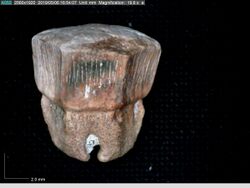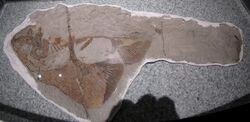Biology:Myledaphus
| Myledaphus | |
|---|---|

| |
| Tooth of Myledaphus bipartitus | |
| Scientific classification | |
| Domain: | Eukaryota |
| Kingdom: | Animalia |
| Phylum: | Chordata |
| Class: | Chondrichthyes |
| Subclass: | Elasmobranchii |
| Superorder: | Batoidea |
| Order: | Rhinopristiformes |
| Family: | Rhinobatidae |
| Genus: | †Myledaphus Cope, 1876[1] |
| Type species | |
| †Myledaphus bipartitus Cope, 1876
| |
| Other species | |
Myledaphus is an extinct genus of guitarfish. It currently contains four valid species found in North America (M. bipartitus, M. pustulosus), South America (M. araucanus), and Central Asia (M. tritus).[4] It is confirmed to have lived during the Late Cretaceous, with possible occurrences in the Paleocene and early Eocene.[3][5] While the genus is mostly known from teeth, two partial skeletons of M. bipartitus have been found in the Dinosaur Park Formation of Alberta.[6]
Biology
Myledaphus remains have been found both in marine and fluvial (freshwater) deposits, suggesting it could tolerate a range of salinity.[7] In the Hell Creek Formation, composed predominantly of floodplain and riverine deposits, Myledaphus teeth are very common, accounting for a significant fraction of vertebrate remains found in microsites.[7]
Myledaphus has a durophagus dentition with blunt, polygonal-shaped (hexagonal to rhombic) teeth tessellated into a pavement suited for crushing and grinding hard-bodied prey. Many of their teeth show wear consistent with feeding on mollusks, which were common in the rivers of North America during the Late Cretaceous.[7]
References
- ↑ Cope, E.D. (1876). "Descriptions of some vertebrate remains from the Fort Union beds of Montana". Proceedings of the Academy of Natural Sciences of Philadelphia 28: 248–261. https://www.biodiversitylibrary.org/item/84760#page/278/mode/1up.
- ↑ Nessov, L.A.; Udovitschenko, N.I. (1986). "Novyye nakhodki ostatkov pozvonochnykh mela i paleogena Sredney Azii [New findings of vertebrate remains from the Cretaceous and Paleogene of Central Asia"]. Voprosy Paleontologii 9: 129–136. https://www.researchgate.net/publication/283694665_New_findings_of_Cretaceous_and_Paleogene_vertebrate_remains_of_Soviet_Middle_Asia.
- ↑ 3.0 3.1 Cook, T.D.; Newbrey, M.G.; Brinkman, D.B.; Kirkland, J.I. (2014). "Euselachians from the freshwater deposits of the Hell Creek Formation of Montana". Geological Society of America Special Paper 503: 229–246. doi:10.1130/2014.2503(08).
- ↑ 4.0 4.1 Otero, R.A. (2019). "Myledaphus araucanus sp. nov. (Batomorphi, Rajiformes incertae sedis), a new Late Cretaceous ray from the austral Pacific, and first occurrence of the genus in the Southern Hemisphere". Cretaceous Research 100: 82–90. doi:10.1016/j.cretres.2019.03.025.
- ↑ Cappetta, H. (2012). Handbook of Paleoichthyology. Volume 3E. Chondrichthyes. Mesozoic and Cenozoic Elasmobranchii: Teeth.. Munich: Verlag Dr. Friedrich Pfeil. ISBN 978-3-89937-148-2.
- ↑ Neuman, A.G.; Brinkman, D.B. (2005). "Fishes of the fluvial beds". Dinosaur Provincial Park: A Spectacular Ancient Ecosystem Revealed. Bloomington, IN: Indiana University Press. pp. 167–185. ISBN 978-0253345950. https://www.researchgate.net/publication/287664210_Fishes_of_the_fluvial_beds.
- ↑ 7.0 7.1 7.2 Hoffman, Brian L. et al. “Dental Structure of the Late Cretaceous (Maastrichtian) Guitarfish (Neoselachii: Batoidea) Myledaphus pustulosus from the Hell Creek Formation of Garfield County, Montana.” Transactions of the Kansas Academy of Science 121 (2018): 279 - 296.
Wikidata ☰ Q22105132 entry
 |


